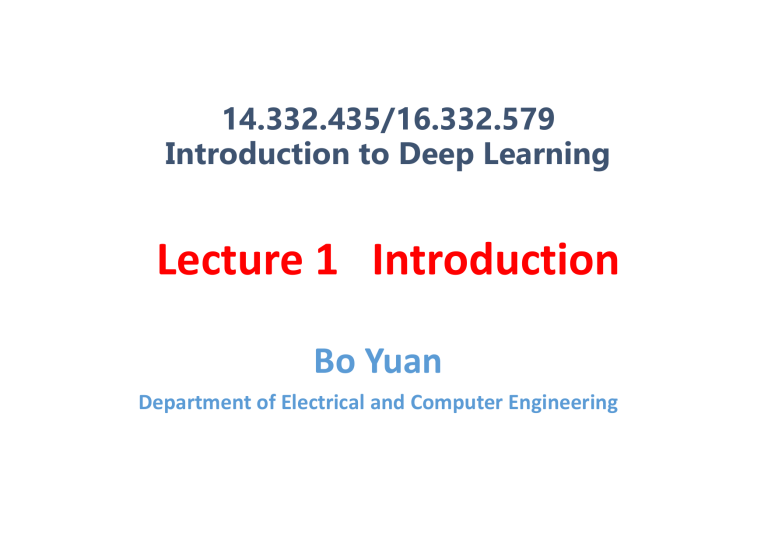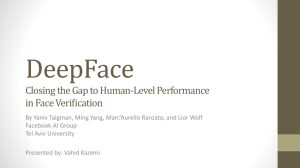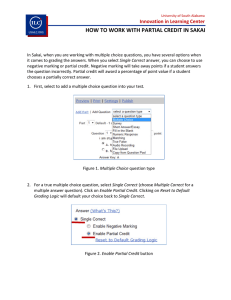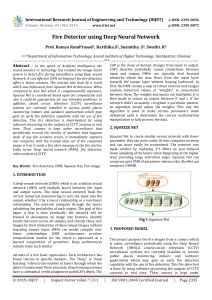
14.332.435/16.332.579 Introduction to Deep Learning Lecture 1 Introduction Bo Yuan Department of Electrical and Computer Engineering Today’s Agenda • Introduction to Deep Learning • Course Information What is Machine Learning Artificial Intelligence Expert systems Symbolic approach …… Machine Learning “Field of study that gives computers the ability to learn without being explicitly programmed” ‐ Arthur Samuel, 1959 Rule engine …… Example: Classification Task An image classifier Plane Unlike many tasks, e.g. sorting a list of numbers, no obvious ways to hard‐code the algorithm for recognizing a plane or other classes. Why Machine Learning Such type of tasks is everywhere Machine Learning: Data‐driven Approach 1. Collect a dataset of images and labels 2. Use Machine Learning to train a classifier 3. Evaluate the classifier on new images Machine Learning is Good At • Recognizing patterns • Objects in real scenes • Facial identifies or facial expressions • …… • Recognizing anomalies • Unusual sequences of credit card transactions • Unusual patterns of sensor readings in a nuclear power plant • …… • Prediction • Future stock prices or currency exchange rates • Which movies will a person like? • …… • ...... Q: What field is ML not good at? Focus of This Course: Deep learning Deep Learning: (Deep) neural network Artificial Intelligence Machine Learning Symbolic approach …… Neural Network Genetic SNN algorithm Deep Neural …… DNN Network Probabilistic graph Expert systems Kernel Rule engine Method …… …… What is Deep Learning (Deep Neural Network) • A type of artificial neural network • “Deep Neural Network (DNN)”: more than 2 hidden layers. Inspire Artificial Neural Network Why Deep learning The most dominated ML algorithm • Achieving record‐breaking performance • Huge social and media impact • Widely popular and adopted in industry Record‐breaking Performance (Vision) 1,000 object classes 1,431,167 images Russakovsky et al. IJCV 2015 Record‐breaking Performance (Speech) DNN‐based Huang et al. CACM 2014 Record‐breaking Performance (NLP) SQuAD: The Stanford Question Answering Dataset Social and Media Impact Wide Deployment in Industry https://pandaily.com Unprecedented Popularity This Course Will Talk about Energy‐efficient Deep Learning Energy‐efficient means • Execute DNNs fast • Execute DNNs with less power Energy = Power x Processing Time Why Energy‐efficient Deep learning • Running DNNs are expensive • DNNs are continuing to scale • Especially important for on‐device intelligence Running DNNs are expensive Storage intensive 175B Parameters GPT‐3 from OpenAI Computation intensive 11.3G MAC Resnet‐152 from Microsoft 1 MAC=1 Multiplication + 1 Addition Challenge on Energy Efficiency M. Horowitz et al., ISSCC 2014 Mobile Devices Datacenter 1920 CPUs 280 GPUs $3,000/game for M. Horowitz et al., ISSCC 2014 DNNs are Continuing to Scale Accuracy Storage Data Models Computation K. He, ICML Tutorial 2016 K. He, ICML Tutorial 2016 Path to Achieve Energy‐efficient Deep Learning SW/HW co‐design co‐optimization • Design specialized hardware architecture Covered by to optimize memory access 14.332.479/16.332.574 to optimize computing dataflow (VLSI Design) • Design efficient low‐cost train/test algorithms to compress sizes of DNNs to accelerate computation of DNNs One Path: Innovation on Hardware GPU vs CPU Design Energy‐efficient DNN is Emerging Another Path: Innovation on Algorithm SW/HW co‐design co‐optimization • Design specialized hardware architecture to optimize memory access to optimize computing dataflow • Design efficient low‐cost train/test algorithms to compress sizes of DNNs Covered by This Course to accelerate computation of DNNs Importance in Academia Security of Deep Learning “EXPLAINING AND HARNESSING ADVERSARIAL EXAMPLES,” I. Goodfellow etc. Course Information Topics Covered in This Course • Machine learning basics • DNN basics, construction, training, application • Algorithm design for energy‐efficient DNN • Vulnerability and Robustness of DNN Expected Learning Outcomes • Knowledge of math foundation of DNN • Coding experience for DNN training/evaluation • Knowledge of compact and fast DNN design • Knowledge for attack & defending DNN models • • • • • • • • • • • • Related Courses 01:198:444 Topics in Computer Science (Deep Learning) 16:198:536 Machine Learning 16:198:534 Computer Vision 16:198:520 Introduction to Artificial Intelligence 16:198:535 Pattern Recognition: Theory & Applications 16:198:543 Massive Data Storage, Retrieval and Deep Learning 16:332:561 Machine Vision 16:332:579 Machine Learning for IoT 16:332:445 Machine Learning for Engineers 16:332:512 Nonlinear Adaptive Control and Learning 16:332:525 Optimum Signal Processing and ML 16:332:549 Detection and Estimation Theory: Inference and ML Related Conferences http://csrankings.org Instructor • Bo Yuan, Ph.D, Assistant Professor in ECE • Email: bo.yuan@soe.rutgers.edu • Research Areas: 1) Deep learning algorithm 2) Hardware architecture of deep learning 3) Security of Deep learning 4) Deep learning applications Teaching Assistant • This course is not assigned with teaching assistants • Two of my PhD students are volunteer TA Email: Huy Phan huy.phan@rutgers.edu Xiao Zang xz514@scarletmail.rutgers.edu Office Hours • Instructor ‐‐ Time: 1:30pm‐2:30pm (or appointment via email) ‐‐ https://rutgers.webex.com/meet/by163 • Volunteer TAs ‐‐ Send emails to volunteer TA for experiment questions ‐‐ Huy Phan: Monday 3pm‐4pm https://rutgers.zoom.us/j/8539066640?pwd=anJ2Vkpia0lHdFJqa1pRd1IxanV0UT09 Communication A lot of information will be posted on the Sakai • Syllabus • Lecture slides • Homework & solutions • Reading materials: papers, tutorials • Any update & notification Check your emails frequently • Timely notice will also be sent via emails • Contact with me via email for any request Course Materials • No textbook required (DL develops fast) • Reference book ‐‐ “Deep Learning” by Ivan Goodfellow et.al • Online tutorials links (very useful) • Research papers • Online courses (see acknowledgement) This Course is Very “Diverse” • Course content spans software and hardware • Background of class vary very much • Students have different computing resource (CPU/GPU) Diverse Background of Class 20 undergraduate students, 40+ graduate students. Solution • This course covers the fundamental and core parts of deep learning basics and algorithms • Self‐contained, no prior knowledge of machine learning • Interesting students can take advanced Type‐B project Diverse Available Computing Resource • Large‐scale deep learning heavily depends on GPU • Use of GPU is not required in this course • All required programming‐related homework and Type‐A final project can be done in CPU (small dataset, small network model) • You are free to program on GPU if you want. • For Type‐B projects, access to GPUs in my research lab is possible (application and approval needed, depending on available resource) Grading • Homework (50%) • Online Quizzes on Sakai (10%) • Final Project (40%) Homework • A typical homework contains two parts ‐‐ hand‐written part (can submit in the class or via Sakai) ‐‐ programming part (submit online via Sakai) • Programming part may have later due dates • No late homework (unless for special circumstances) • 10 % penalty per calendar day for late homework • No late homework once solutions are posted on Sakai • See syllabus for other details Quiz • Online Quizzes will be posted in Sakai for one week • Each quiz contains several multi‐choice questions • New quiz will be announced via email and Sakai • No makeup quizzes for any reason Final Programming Project • Two types of project: Type‐A and Type‐B • Type‐A project ‐‐ task to use small‐size neural network on small dataset ‐‐ CPU is enough for Type‐A project • Type‐B project ‐‐ task to use large‐size neural network on large dataset ‐‐ GPU is preferred for Type‐B project • You can choose both Type‐A and Type‐B projects ‐‐ Only one type of project (higher score) is needed for grading Type‐A Project • • • • • The task is fixed and given by instructor Some candidate tasks can be chosen A project report is required at the end of semester No team for Type‐A project Recommended for students who have little prior experience in DNNs or only CPU resource • Details will be posted on Sakai Potential Type‐A Project Tasks • Some potential Type‐A project tasks ‐‐ manually write a small CNN on a small dataset for image classification for target accuracy ‐‐ write a small RNN on a small dataset for speech recognition or language translation for target accuracy • Here “Manually” means no library module, no auto gradient Type‐B Project • The task is flexible ‐‐ Some candidate tasks will be given ‐‐ Students can also propose your own projects • A project report is required at the end of semester • Access to GPU in my research lab is possible • Team (2 students/per team) allowed • Recommended for students who have some prior experience in DNNs and GPU resource • Details will be posted on Sakai Propose Your Own Type‐B Projects • Good opportunity to explore some advanced topics ‐‐ Replicate experiment of a published paper ‐‐ Apply DNNs for a domain problem (CV, NLP etc.) ‐‐ A new idea to improve performance of DNN • A project proposal is needed for approval ‐‐ Background, motivation, plan, target… ‐‐ Complexity should be higher than Type‐A project • Details will be posted on Sakai Potential Type‐B Project Tasks • Some potential Type‐B project tasks ‐‐ Applying large DNNs in classical tasks in CV, NLP etc. ‐‐ Applying large DNNs in new domains in EECS and more ‐‐ Replicate a DNN attack/defense approach ‐‐ Replicating a DNN pruning method on large network ‐‐ … • You can propose your own idea Programming Languages • Python is mandatory ‐‐ No C/C++, Matlab, R or Java any more… • Recommend Python (3.x preferred, 2.x is also accepted) • Links to Python online tutorials will be posted in Sakai Why Python • Dominated in machine learning community • Very easy to use, well‐suited for beginners • The two most popular deep learning frameworks are based on python Zoo of Deep Learning Frameworks Deep Learning Frameworks • Deep learning frameworks can be viewed as “library” specific for neural networks. • If not forbidden, using frameworks can save you a lot of time in programming • Pytorch is recommended in this course • A short tutorial of installing Pytorch are posted in Sakai • You are free to use your preferred framework • TAs’ support on Pytorch, Tensorflow Why Pytorch • Very easy for beginners to use • Very popular in both academia and industry https://cv‐tricks.com/ Some Suggestion to Learn Deep Learning and This Course • Understand the underlying math ‐‐ Math is always important • Spend time on programming and model tuning ‐‐ Deep learning is famous for its “black box” property • Search, Read and Try ‐‐ Github, Arxiv, forum, Stackoverflow, Reddit, Quora… • Practice, Practice, and Practice Acknowledgement Many materials of the slides of this course are adopted and re‐produced from several deep learning courses and tutorials. • Prof. Fei‐fei Li, Stanford, CS231n: Convolutional Neural Networks for Visual Recognition (online available) • Prof. Andrew Ng, Stanford, CS230: Deep learning (online available) • Prof. Yanzhi Wang, Northeastern, EECE7390: Advance in deep learning • Prof. Jianting Zhang, CUNY, CSc G0815 High‐Performance Machine Learning: Systems and Applications • Prof. Vivienne Sze, MIT, “Tutorial on Hardware Architectures for Deep Neural Networks” • Pytorch official tutorial https://pytorch.org/tutorials/





